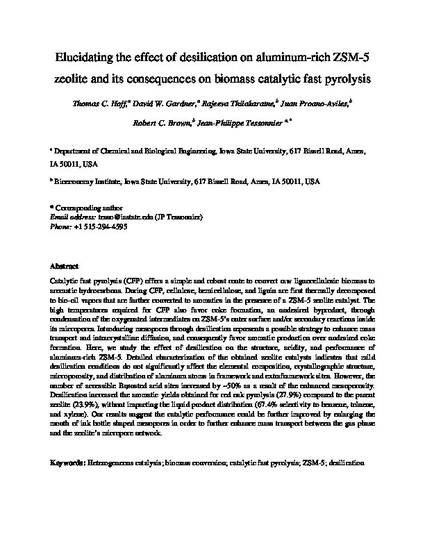
Catalytic fast pyrolysis (CFP) offers a simple and robust route to convert raw lignocellulosic biomass to aromatic hydrocarbons. During CFP, cellulose, hemicellulose, and lignin are first thermally decomposed to bio-oil vapors that are further converted to aromatics in the presence of a ZSM-5 zeolite catalyst. The high temperatures required for CFP also favor coke formation, an undesired byproduct, through condensation of the oxygenated intermediates on ZSM-5′s outer surface and/or secondary reactions inside its micropores. Introducing mesopores through desilication represents a possible strategy to enhance mass transport and intracrystalline diffusion, and consequently favor aromatic production over undesired coke formation. Here, we study the effect of desilication on the structure, acidity, and performance of aluminum-rich ZSM-5. Detailed characterization of the obtained zeolite catalysts indicates that mild desilication conditions do not significantly affect the elemental composition, crystallographic structure, microporosity, and distribution of aluminum atoms in framework and extraframework sites. However, the number of accessible Brønsted acid sites increased by ∼50% as a result of the enhanced mesoporosity. Desilication increased the aromatic yields obtained for red oak pyrolysis (27.9%) compared to the parent zeolite (23.9%), without impacting the liquid product distribution (67.4% selectivity to benzene, toluene, and xylene). Our results suggest the catalytic performance could be further improved by enlarging the mouth of ink bottle shaped mesopores in order to further enhance mass transport between the gas phase and the zeolite’s micropore network.
Available at: http://works.bepress.com/jean-philippe_tessonnier/27/

This is a manuscript of an article published as Hoff, Thomas C., David W. Gardner, Rajeeva Thilakaratne, Juan Proano-Aviles, Robert C. Brown, and Jean-Philippe Tessonnier. "Elucidating the effect of desilication on aluminum-rich ZSM-5 zeolite and its consequences on biomass catalytic fast pyrolysis." Applied Catalysis A: General 529 (2017): 68-78. DOI: 10.1016/j.apcata.2016.10.009. Posted with permission.